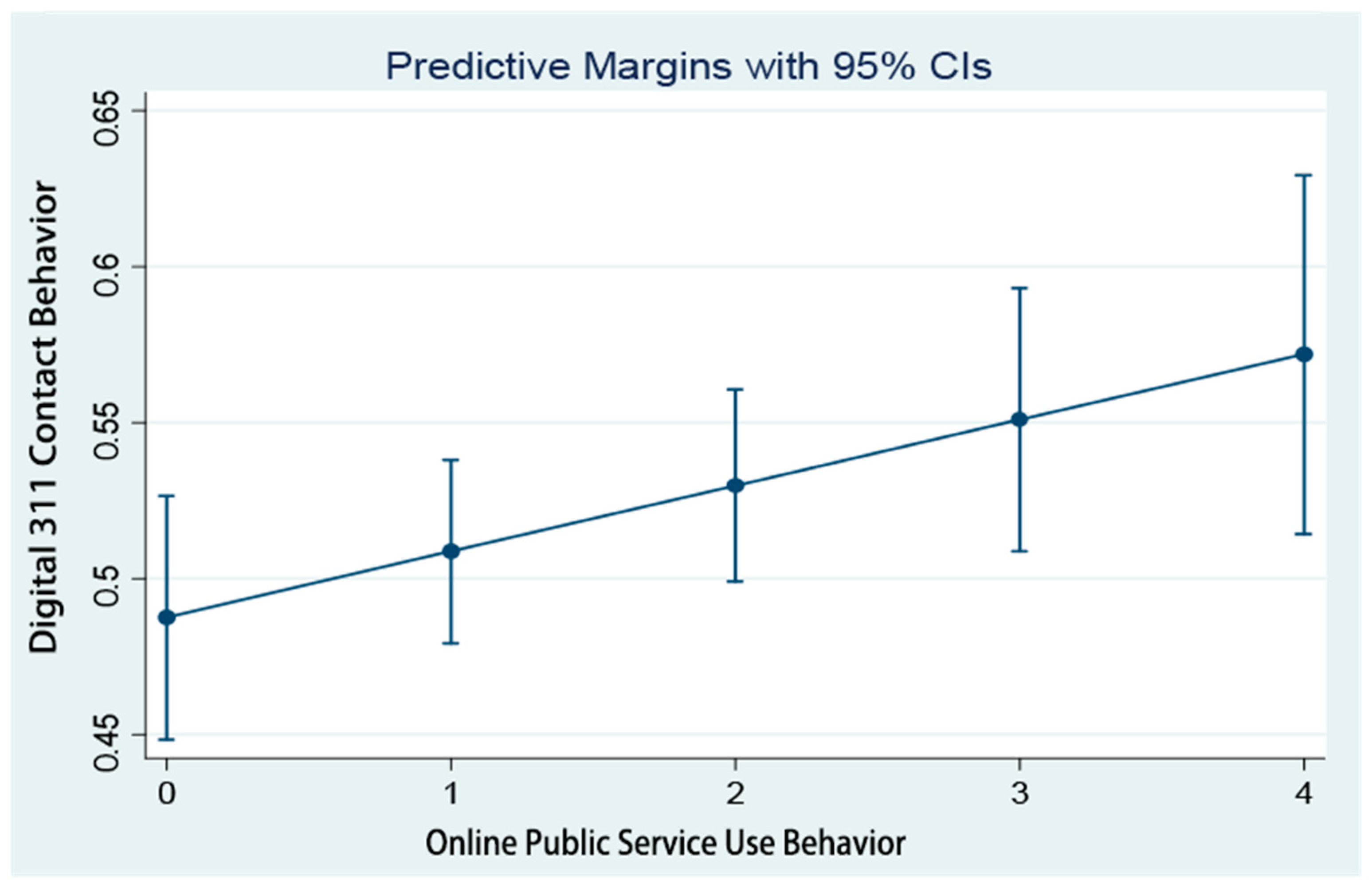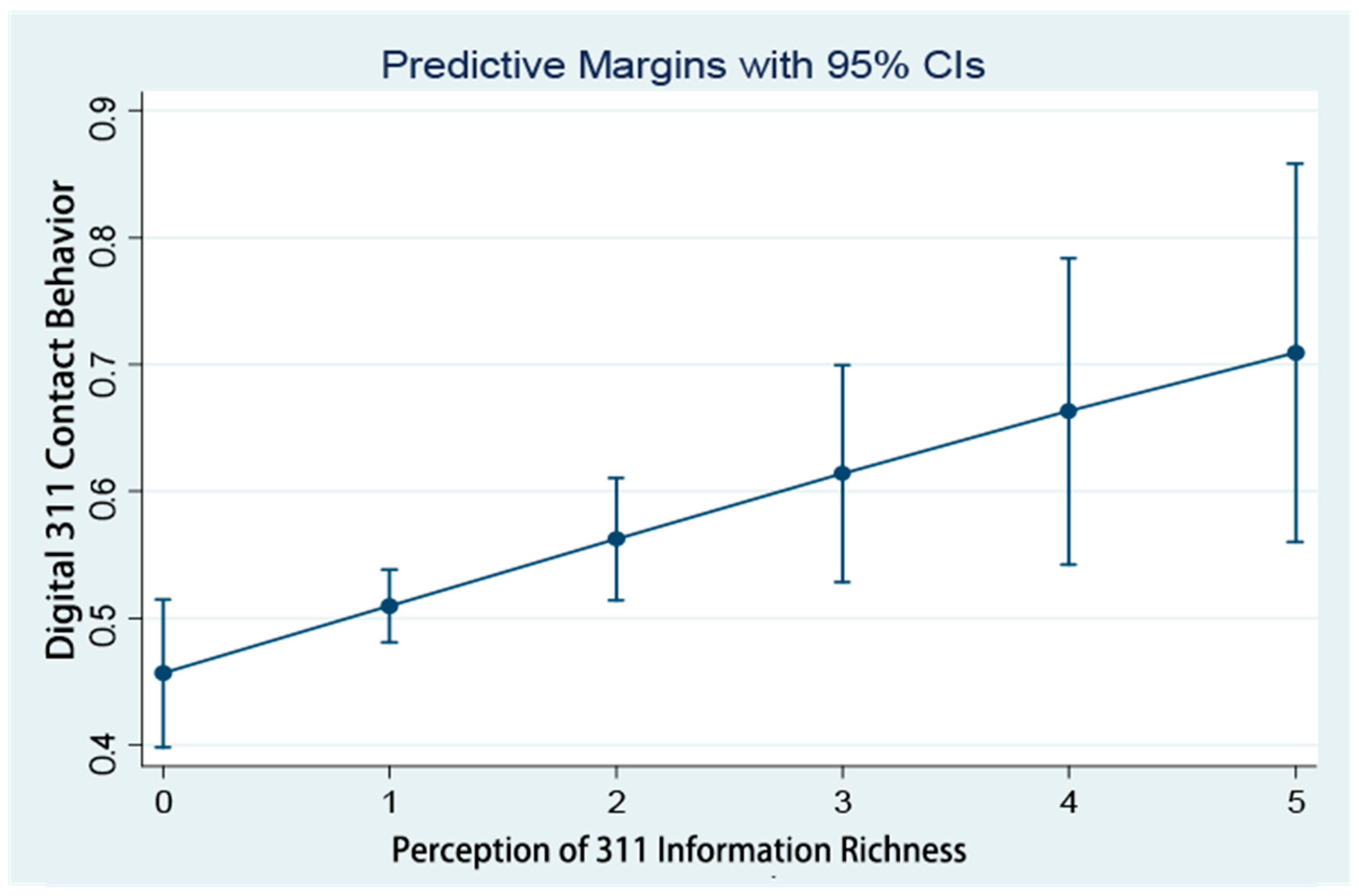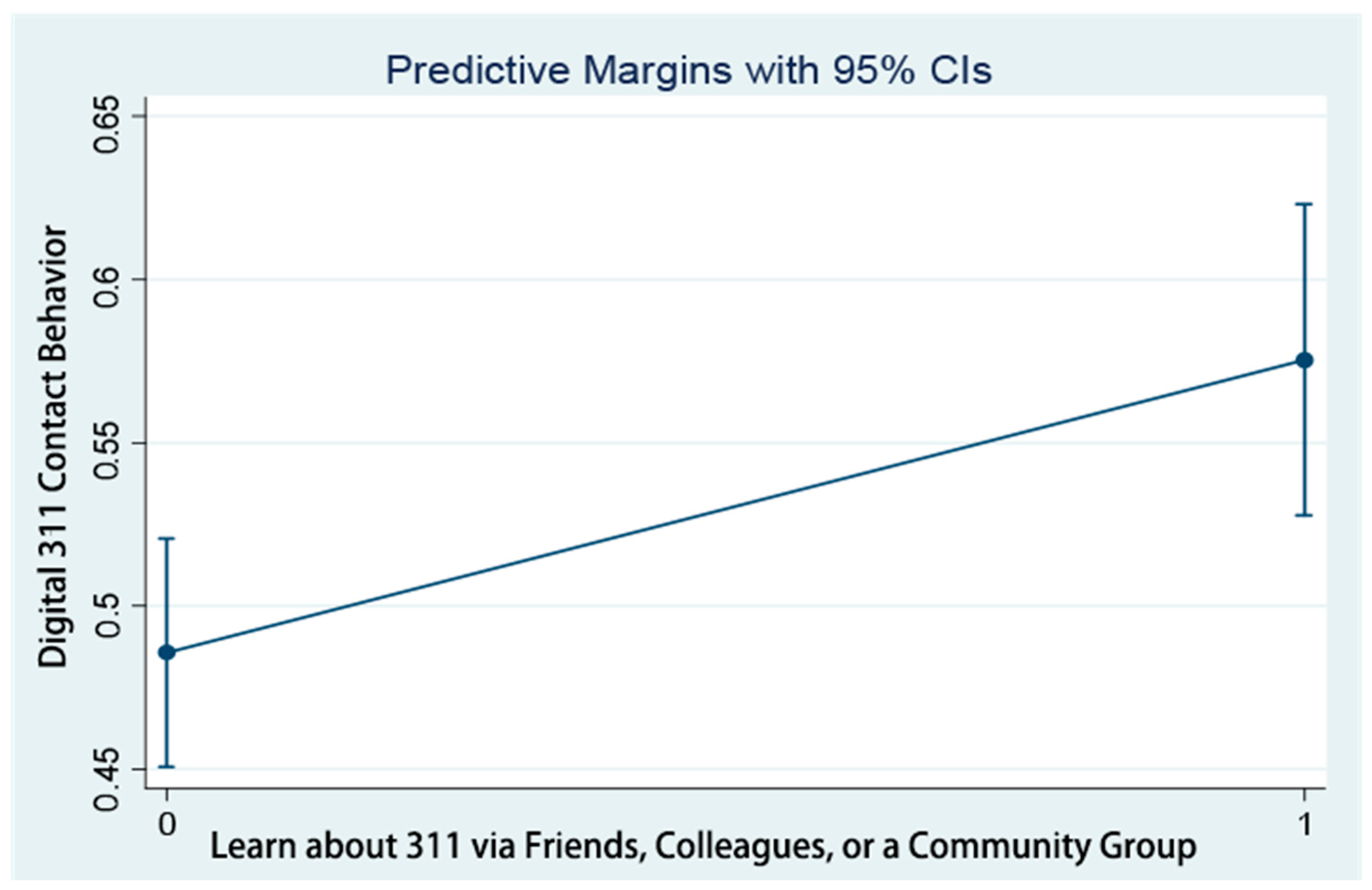Citizen Relationship Management System Users’ Contact Channel Choices: Digital Approach or Call Approach?
Abstract
:1. Introduction
2. Literature Review
3. Research Model Development and Hypotheses
3.1. Online Public Service Use Behavior
3.2. Perception of 311 Information Richness
3.3. Information Sources Related to 311
4. Research Method
4.1. Survey Data Collection
4.2. Measurements
5. Results and Analysis
6. Discussion
7. Conclusions
Acknowledgments
Conflicts of Interest
References
- Collins, B.K.; Kim, H.J. Are satisfied citizens willing to pay more? Public sector consumerism as equitable social exchange. Public Money Manag. 2009, 29, 109–116. [Google Scholar] [CrossRef]
- Clark, B.Y.; Brudney, J.L.; Jang, S.G. Coproduction of government services and the new information technology: Investigating the distributional biases. Public Adm. Rev. 2013, 73, 687–701. [Google Scholar] [CrossRef]
- Khalil Moghaddam, B.; Khatoon-Abadi, A. Factors affecting ICT adoption among rural users: A case study of ICT Center in Iran. Telecommun. Policy 2013, 37, 1083–1094. [Google Scholar] [CrossRef]
- Wang, X. Assessing public participation in US cities. Public Perform. Manag. Rev. 2001, 24, 322–336. [Google Scholar] [CrossRef]
- Fountain, J.E. Building the Virtual State: Information Technology and Institutional Hange; Brookings Institution Press: Washington, DC, USA, 2001. [Google Scholar]
- Reddick, C.G. Citizen interaction with e-government: From the streets to servers? Gov. Inf. Q. 2005, 22, 38–57. [Google Scholar] [CrossRef]
- Mergel, I. A framework for interpreting social media interactions in the public sector. Gov. Inf. Q. 2013, 30, 327–334. [Google Scholar] [CrossRef]
- Bimber, B.A. Information and American Democracy: Technology in the Evolution of Political Power; Cambridge University Press: Cambridge, UK, 2003. [Google Scholar]
- Min, S.J. From the digital divide to the democratic divide: Internet skills, political interest, and the second-level digital divide in political internet use. J. Inf. Technol. Politics 2010, 7, 22–35. [Google Scholar] [CrossRef]
- Morris, D.S.; Morris, J.S. Digital inequality and participation in the political process real or imagined? Soc. Sci. Comput. Rev. 2013, 31, 589–600. [Google Scholar] [CrossRef]
- Prieger, J.E.; Hu, W.M. The broadband digital divide and the nexus of race, competition, and quality. Inf. Econ. Policy 2008, 20, 150–167. [Google Scholar] [CrossRef]
- Dimitrova, D.V.; Chen, Y.C. Profiling the adopters of E-government information and services the influence of psychological characteristics, civic mindedness, and information channels. Soc. Sci. Comput. Rev. 2006, 24, 172–188. [Google Scholar] [CrossRef]
- Durante, M. The online construction of personal identity through trust and privacy. Information 2011, 2, 594–620. [Google Scholar] [CrossRef]
- Fu, K.J.; Lee, C.P. The role of trust in the prioritization of channel choices. In Electronic Government; Springer: Berlin/Heidelberg, Germany, 2014; pp. 96–105. [Google Scholar]
- Reddick, C.G.; Turner, M. Channel choice and public service delivery in Canada: Comparing e-government to traditional service delivery. Gov. Inf. Q. 2012, 29, 1–11. [Google Scholar] [CrossRef]
- Carlson, J.R.; Zmud, R.W. Channel expansion theory and the experiential nature of media richness perceptions. Acad. Manag. J. 1999, 42, 153–170. [Google Scholar] [CrossRef]
- Pieterson, W.; Ebbers, W. The use of service channels by citizens in the Netherlands: Implications for multi-channel management. Int. Rev. Admin. Sci. 2008, 74, 95–110. [Google Scholar] [CrossRef]
- Pieterson, W.J. Channel Choice: Citizens’ Channel Behavior and Public Service Channel Strategy; University of Twente: Enschede, The Netherlands, 2009. [Google Scholar]
- West, D.M. Digital Government: Technology and Public Sector Performance; Princeton University Press: Princeton, NJ, USA, 2005. [Google Scholar]
- Schellong, A.; Mans, D. Citizens preferences towards one-stop government. In Proceedings of the 2004 Annual National Conference on Digital Government Research, Seattle, WA, USA, 24–26 May 2004; p. 11.
- Thomas, J.C.; Streib, G. The new face of government: Citizen-initiated contacts in the era of E-government. J. Public Admin. Res. Theory 2003, 13, 83–102. [Google Scholar] [CrossRef]
- Reddick, C.G. Citizen-initiated contacts with government: Comparing phones and websites. J. E-Gov. 2005, 2, 27–53. [Google Scholar] [CrossRef]
- Ebbers, W.E.; Pieterson, W.J.; Noordman, H.N. Electronic government: Rethinking channel management strategies. Gov. Inf. Q. 2008, 25, 181–201. [Google Scholar] [CrossRef]
- Teerling, M.L.; Pieterson, W. Multichannel marketing: An experiment on guiding citizens to the electronic channels. Gov. Inf. Q. 2010, 27, 98–107. [Google Scholar] [CrossRef]
- Reddick, C.G.; Abdelsalam, H.M.; Elkadi, H.A. Channel choice and the digital divide in E-government: The case of Egypt. Inf. Technol. Dev. 2012, 18, 226–246. [Google Scholar] [CrossRef]
- Hung, M.J. Building citizen-centred E-government in Taiwan: Problems and prospects. Aust. J. Public Admin. 2012, 71, 246–255. [Google Scholar] [CrossRef]
- O’Brien, D.T. Custodians and custodianship in urban neighborhoods: A methodology using reports of public issues received by a city’s 311 hotline. Environ. Behav. 2015, 47, 304–327. [Google Scholar] [CrossRef]
- Haddon, L. Social exclusion and information and communication technologies lessons from studies of single parents and the young elderly. New Media Soc. 2000, 2, 387–406. [Google Scholar] [CrossRef] [Green Version]
- van Deursen, A.; Pieterson, W. The Internet as a service channel in the public sector. In Proceedings of the ICA Conference, Dresden, Germany, 19–23 June 2006.
- Susanto, T.D.; Goodwin, R. User acceptance of SMS-based e-government services: Differences between adopters and non-adopters. Gov. Inf. Q. 2013, 30, 486–497. [Google Scholar] [CrossRef]
- D’Urso, S.C.; Rains, S.A. Examining the scope of channel expansion: A test of channel expansion theory with new and traditional communication media. Manag. Commun. Q. 2008, 21, 486–507. [Google Scholar] [CrossRef]
- Enoch, Y.; Soker, Z. Age, gender, ethnicity and the digital divide: University students’ use of web-based instruction. Open Learn. 2006, 21, 99–110. [Google Scholar] [CrossRef]
- Wu, W.N.; Jung, K. A missing link between citizen participation, satisfaction, and public performance: Evidences from the city and county of San Francisco. Int. J. Public Sect. Perform. Manag. 2016, 2, 392–410. [Google Scholar] [CrossRef]
- Rogers, E.M. Diffusion of Innovations; Simon and Schuster: New York, NY, USA, 2010. [Google Scholar]
- Thomas, J.C. Citizen, Customer, Partner: Engaging the Public in Public Management; ME Sharpe: Armonk, NY, USA, 2012. [Google Scholar]
- Jaeger, P.T.; Bertot, J.C. Transparency and technological change: Ensuring equal and sustained public access to government information. Gov. Inf. Q. 2010, 27, 371–376. [Google Scholar] [CrossRef]
- Walton, P. Digital Information and Value. Information 2015, 6, 733–749. [Google Scholar] [CrossRef]
- Jackson, L.A.; Zhao, Y.; Kolenic, A., III; Fitzgerald, H.E.; Harold, R.; Von Eye, A. Race, gender, and information technology use: The new digital divide. CyberPsychol. Behav. 2008, 11, 437–442. [Google Scholar] [CrossRef] [PubMed]
- Robinson, J.P.; DiMaggio, P.; Hargittai, E. New social survey perspectives on the digital divide. It Soc. 2003, 1, 1–22. [Google Scholar]
- van Dijk, J.A. Digital divide research, achievements and shortcomings. Poetics 2006, 34, 221–235. [Google Scholar] [CrossRef]
- Servon, L.J. Bridging the Digital Divide: Technology, Community and Public Policy; John Wiley & Sons: Hoboken, NJ, USA, 2008. [Google Scholar]
- Walther, J.B. Theories of computer-mediated communication and interpersonal relations. Handb. Interpers. Commun. 2011, 4, 443–479. [Google Scholar]
- Carlson, J.R.; George, J.F. Media appropriateness in the conduct and discovery of deceptive communication: The relative influence of richness and synchronicity. Group Decis. Negot. 2004, 13, 191–210. [Google Scholar] [CrossRef]
- Hill, R.; Beynon-Davies, P.; Williams, M.D. Older people and internet engagement: Acknowledging social moderators of internet adoption, access and use. Inf. Technol. People 2008, 21, 244–266. [Google Scholar] [CrossRef]
- Berger, P.; Trexler, S. Choosing Web 2.0 Tools for Learning and Teaching in A Digital World; Libraries Unlimited, Inc.: Englewood, CO, USA, 2010. [Google Scholar]
- Chen, Y.C.; Dimitrova, D.V. Electronic government and online engagement: Citizen interaction with government via web portals. Int. J. Electron. Gov. Res. 2006, 2, 54–76. [Google Scholar] [CrossRef]
- Nisbet, E.C.; Stoycheff, E.; Pearce, K.E. Internet use and democratic demands: A multinational, multilevel model of Internet use and citizen attitudes about democracy. J. Commun. 2012, 62, 249–265. [Google Scholar] [CrossRef]
- Kavanaugh, A.; Sheetz, S.D.; Hassan, R.; Yang, S.; Elmongui, H.G.; Fox, E.A.; Shoemaker, D.J. Between a rock and a cell phone: Communication and information technology use during the 2011 Egyptian uprising. In Proceedings of the 2012 Information Systems for Crisis Response and Management Conference, Vancouver, BC, Canada, 22–25 April 2012.
- Fulk, J.; Schmitz, J.; Ryu, D. Cognitive elements in the social construction of communication technology. Manag. Commun. Q. 1995, 8, 259–288. [Google Scholar] [CrossRef]
- Cuillier, D.; Piotrowski, S.J. Internet information-seeking and its relation to support for access to government records. Gov. Inf. Q. 2009, 26, 441–449. [Google Scholar] [CrossRef]
- Nam, T. Determining the type of e-government use. Gov. Inf. Q. 2014, 31, 211–220. [Google Scholar] [CrossRef]
- Alawneh, A.; Al-Refai, H.; Batiha, K. Measuring user satisfaction from e-Government services: Lessons from Jordan. Gov. Inf. Q. 2013, 30, 277–288. [Google Scholar] [CrossRef]
- Alomari, M.; Woods, P.; Sandhu, K. Predictors for e-government adoption in Jordan: Deployment of an empirical evaluation based on a citizen-centric approach. Inf. Technol. People 2012, 25, 207–234. [Google Scholar] [CrossRef]
- George, J.F.; Carlson, J.R.; Valacich, J.S. Media selection as a strategic component of communication. MIS Q. 2013, 37, 1233–1251. [Google Scholar]
- Kupritz, V.W.; Hillsman, T. The impact of the physical environment on supervisory communication skills transfer. J. Bus. Commun. 2011, 48, 148–185. [Google Scholar] [CrossRef]
- Jung, K.; Park, S.J.; Wu, W.N.; Park, H.W. A webometric approach to policy analysis and management using exponential random graph models. Qual. Quant. 2015, 49, 581–598. [Google Scholar] [CrossRef]



| Variables | Measurement |
|---|---|
| Dependent Variable | |
| Digital 311 channel choice | Whether 311 users contact the SF government via digital approach (digital approach = 1). |
| Independent Variables | |
| Online public service use behavior | Citizen response of their frequent use of online library services (At least once a week = 4, At least once a month = 3, Several times a year = 2, Once or twice a year = 1, and Never = 0). |
| Perception of 311 information richness | Sources of detail contained in a piece of 311 technology learning information (0–5). |
| Learn about 311 via friends, colleagues, or a community group | Citizen response: do they learn about 311 via friends, colleagues, or a community group (Yes = 1). |
| Learn about 311 via TV or radio | Citizen response: do they learn about 311 via TV or radio (Yes = 1). |
| Control Variables | |
| Gender | Citizen response to their gender (Male = 1). |
| Age | Age group (18–34 = 1, 35–44 = 2, 45–54 = 3, 55–64 = 4, and 65+ = 5). |
| Income | Income (less than $10,000 = 1, $10,000 to $24,999 = 2, $25,000 to $49,999 = 3, $50,000 to $99,999 = 4, and $100,000 or more = 5). |
| Education | Respondent’s highest education completed. (Less than high school = 1; High school = 2; Less than four years of college = 3; Four or more years of college/Post graduate = 4). |
| Race | Citizen response to their race. White/Caucasian = 1, Asian or Pacific Islander = 2, Latino/Hispanic = 33, the Black = 4, and Other = 5. |
| Working status | Employee (Yes = 1). |
| Geographic region of city | Citizens’ response of the geographic region of city (Districts 1–11). |
| Variables | Obs. | Mean | Std. Dev. | Min. | Max. |
|---|---|---|---|---|---|
| Digital 311 channel choice | 1311 | 0.51 | 0.50 | 0 | 1 |
| Perception of 311 information richness | 1311 | 1.13 | 0.65 | 0 | 5 |
| Learn about 311 via friends, colleagues, or a community group | 1311 | 0.34 | 0.47 | 0 | 1 |
| Learn about 311 via TV or radio | 1311 | 0.20 | 0.40 | 0 | 1 |
| Online public service use behavior | 1248 | 1.40 | 1.49 | 0 | 4 |
| Age | 1311 | 3.08 | 1.35 | 1 | 5 |
| Income | 1211 | 3.61 | 1.25 | 1 | 5 |
| Education | 1311 | 3.45 | 0.86 | 1 | 4 |
| Gender | 1311 | 0.48 | 0.50 | 0 | 1 |
| White/Caucasian | 1256 (673) | 0.53 | 0.50 | 0 | 1 |
| Asian or Pacific Islander | 1256 (337) | 0.26 | 0.44 | 0 | 1 |
| Latino/Hispanic | 1256 (138) | 0.11 | 0.31 | 0 | 1 |
| Black | 1256 (63) | 0.05 | 0.22 | 0 | 1 |
| Other (ethnicity) | 1256 (45) | 0.04 | 0.19 | 0 | 1 |
| District 1 | 1311 (112) | 0.09 | 0.29 | 0 | 1 |
| District 2 | 1311 (91) | 0.07 | 0.25 | 0 | 1 |
| District 3 | 1311 (122) | 0.09 | 0.29 | 0 | 1 |
| District 4 | 1311 (96) | 0.07 | 0.26 | 0 | 1 |
| District 5 | 1311(141) | 0.11 | 0.31 | 0 | 1 |
| District 6 | 1311(102) | 0.08 | 0.27 | 0 | 1 |
| District 7 | 1311(115) | 0.09 | 0.28 | 0 | 1 |
| District 8 | 1311(138) | 0.11 | 0.31 | 0 | 1 |
| District 9 | 1311(145) | 0.11 | 0.31 | 0 | 1 |
| District 10 | 1311 (136) | 0.10 | 0.31 | 0 | 1 |
| District 11 | 1311 (103) | 0.08 | 0.27 | 0 | 1 |
| Working | 1311 | 0.70 | 0.45 | 0 | 1 |
| Model One | Model Two | |||||
|---|---|---|---|---|---|---|
| Odds Ratio | Std. Err. | Odds Ratio | Std. Err. | |||
| Main Independent Variables | ||||||
| Perception of 311 information richness | 1.76 | 0.43 | ** | |||
| Learn about 311 via friends, colleagues, or a community group | 1.51 | 0.21 | *** | |||
| Learn about 311 via TV or radio | 0.85 | 0.14 | ||||
| Online public service use behavior | 1.09 | 0.05 | ** | 1.11 | 0.05 | ** |
| Control Variables | ||||||
| Age | 0.72 | 0.04 | *** | 0.73 | 0.04 | *** |
| Income | 1.03 | 0.06 | 1.04 | 0.06 | ||
| Education | 0.92 | 0.08 | 0.91 | 0.08 | ||
| Gender | 1.13 | 0.14 | 1.16 | 0.15 | ||
| Race | ||||||
| Asian or Pacific Islander (vs. White/Caucasian) | 1.34 | 0.22 | * | 1.39 | 0.23 | ** |
| Latino/Hispanic (vs. White/Caucasian) | 1.04 | 0.24 | 1.07 | 0.25 | ||
| Black (vs. White/Caucasian) | 1.29 | 0.40 | 1.30 | 0.40 | ||
| Other (vs. White/Caucasian) | 0.82 | 0.28 | 0.87 | 0.30 | ||
| Supervisorial District | ||||||
| District 1 (vs. District 2) | 1.14 | 0.36 | 1.13 | 0.36 | ||
| District 3 (vs. District 2) | 1.31 | 0.38 | 1.32 | 0.39 | ||
| District 4 (vs. District 2) | 0.75 | 0.23 | 0.79 | 0.25 | ||
| District 5 (vs. District 2) | 1.18 | 0.33 | 1.23 | 0.35 | ||
| District 6 (vs. District 2) | 0.69 | 0.21 | 0.72 | 0.22 | ||
| District 7 (vs. District 2) | 0.76 | 0.22 | 0.75 | 0.22 | ||
| District 8 (vs. District 2) | 0.68 | 0.19 | 0.65 | 0.18 | ||
| District 9 (vs. District 2) | 0.81 | 0.22 | 0.82 | 0.23 | ||
| District 10 (vs .District 2) | 1.29 | 0.38 | 1.35 | 0.40 | ||
| District 11 (vs. District 2) | 0.93 | 0.30 | 0.98 | 0.31 | ||
| Working | 1.28 | 0.20 | 1.28 | 0.20 | ||
| Constant | 1.43 | 0.74 | 2.02 | 0.96 | ||
| Number of Obs. | 1113 | 1113 | ||||
| Log likelihood | −720.61 | −718.34 | ||||
| LR Chi2 | 100.5 | *** | 105.03 | *** | ||
| Pseudo R2 | 0.07 | 0.07 | ||||
© 2017 by the author. Licensee MDPI, Basel, Switzerland. This article is an open access article distributed under the terms and conditions of the Creative Commons Attribution (CC BY) license ( http://creativecommons.org/licenses/by/4.0/).
Share and Cite
Wu, W.-N. Citizen Relationship Management System Users’ Contact Channel Choices: Digital Approach or Call Approach? Information 2017, 8, 8. https://doi.org/10.3390/info8010008
Wu W-N. Citizen Relationship Management System Users’ Contact Channel Choices: Digital Approach or Call Approach? Information. 2017; 8(1):8. https://doi.org/10.3390/info8010008
Chicago/Turabian StyleWu, Wei-Ning. 2017. "Citizen Relationship Management System Users’ Contact Channel Choices: Digital Approach or Call Approach?" Information 8, no. 1: 8. https://doi.org/10.3390/info8010008





